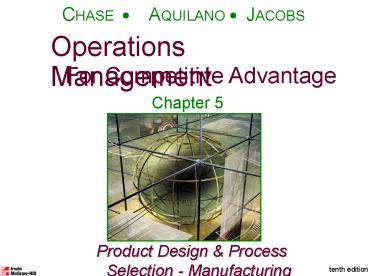Production and Operations Management: Manufacturing and Services PowerPoint PPT Presentation
1 / 23
Title: Production and Operations Management: Manufacturing and Services
1
CHASE AQUILANO JACOBS
Operations Management
For Competitive Advantage
Chapter 5
Product Design ProcessSelection - Manufacturing
tenth edition
2
Chapter 5Product Design Process
Selection-Manufacturing
- Typical Phases of Product Design Development
- Concurrent Engineering
- Designing for the Customer
- QFD
- Design for Manufacturability
- Types of Processes
- Process Flow Structures
- Process Flow Design
- Global Product Design and Manufacturing
3
Typical Phases of Product Design Development
- Concept Development
- Product architecture
- Conceptual design
- Target market
- Product Planning
- Market building
- Small-scale testing
- Investment/financial
4
Typical Phases of Product Design Development
- Product/Process Engineering
- Tools/equipment design
- Building/testing prototypes
- Pilot Production/Ramp-Up
- Volume production and prove out
- Volume increases to commercial targets
- Factory start-up
5
Concurrent EngineeringDefined
- Concurrent engineering can be defined as the
simultaneous development of project design
functions, with open and interactive
communication existing among all team members for
the purposes of reducing time to market,
decreasing cost, and improving quality and
reliability. - Reducing time to market
- Decreasing cost, and
- Improving quality and reliability
6
Designing for the Customer
Ideal Customer Product
7
Designing for the Customer Quality Function
Deployment
- Inter-functional teams from marketing, design
engineering, and manufacturing - Voice of the customer
- Customer requirements
- Does customer always know what he wants?
- Manufacturer must interpret customer wants/needs
- House of Quality
- Team uses customer feedback to make decisions
- Translate customer requirements into goals
8
Designing for the Customer The House of Quality
8
- The McGraw-Hill Companies, Inc., 2001
9
Designing for the Customer Value Analysis/Value
Engineering (VA/VE)
- Achieve equivalent or better performance at a
lower cost while maintaining all functional
requirements defined by the customer. - Technique for determining value content of a
product - Value is what people are willing to pay for
something - Does the item have any design features that are
not necessary? - Can two or more parts be combined into one?
- How can we cut down the weight?
- Are there nonstandard parts that can be
eliminated?
10
Design for Manufacturability
- Traditional Approach
- We design it, you build it or Over the wall
- Very long lead times
- Often cost prohibitive
- Concurrent Engineering
- Lets work together simultaneously
- Team engineering/design concept
- Avoids pitfalls of traditional approach
11
Design for Manufacturing and Assembly
- Greatest improvements related to DFMA arise from
simplification of the product by reducing the
number of separate parts - 1. During the operation of the product, does the
part move relative to all other parts already
assembled? - 2. Must the part be of a different material or be
isolated from other parts already assembled? - 3. Must the part be separate from all other parts
to allow the disassembly of the product for
adjustment or maintenance?
12
Types of Processes
- Conversion
- Converts natural resources to raw materials
- Provides input to others
- E.g., converts iron ore to steel
- Fabrication
- Changes raw materials into a specific form
- E.g., changes sheet metal to car fenders
- Assembly
- Assembles final products
- E.g., assembles the fender into a car
- Testing
13
Process Flow Structure is how a factory organizes
material flow using one or more process
technologies just listed.
- Job shop
- - Small batches of a large number of different
products - Batch shop
- - Stdized job shop, products follow same flow
pattern - Assembly Line
- - Discrete parts mftr on a line, following
sequence - Continuous Flow
- Production of undifferentiated mtls (foods,
chemicals) - Often runs 24 hours/day
14
Exhibit 5.10
15
Virtual FactoryDefined
- A virtual factory can be defined as a
manufacturing operation where activities are
carried out not in one central plant, but in
multiple locations by suppliers and partner firms
as part of a strategic alliance. - Partners must understand their own operations and
that of other partners - The partnership has integrated network of
capabilities.
16
Choosing Among Alternative Processes
- The break-even analysis method
- Visually presents alternative profits/losses
- As a function of units produced/sold
- Choice depends on anticipated demand
- Most suitable when alternatives entails large
fixed costs - Variable costs are proportional to number of
units produced
17
Break-Even Analysis
TR
PROFIT
BEP
VC
TC
LOSS
FC
Quantity
Q
18
Process Flow DesignDefined
- A process flow design can be defined as a mapping
of the specific processes that raw materials,
parts, and subassemblies follow as they move
through a plant. - The most common tools to conduct a process flow
design include assembly drawings, assembly
charts, and operation and route sheets.
19
Process Flow Design
- Assembly drawing
- Exploded view of the product
- Shows its component parts
- Assembly chart
- Uses information in assembly drawing
- Defines how parts go together
- Shows their order of assembly
- Operation and route sheet
- Specifies operations and process routing
- Shows types of equipment/tools requirements
20
Example Assembly Chart (Gozinto)
From Exhibit 5.14
21
Example Process Flow Chart
Material Received from Supplier
No, Continue
Inspect Material for Defects
Defects found?
Yes
Return to Supplier for Credit
22
Global Product Design and Manufacturing Strategies
- Joint Ventures
- Two companies form a third independent Co.
- For example, GM/Toyota
- Facilitates globalization
- Strategic Suppliers
- Suppliers with operations matching parent
companys foreign operation - Provide materials and manufacturing know-how
- Global Product Design Strategy
- Develop standard modules common to all units sold
globally (Honda Accord chassis)
23
Measuring Product Development Performance
- Time-to-market
- - Frequency of new products introduction
- Productivity
- - Cost of materials and tooling per project
- Quality
- - Designperformance and customer satisfaction

